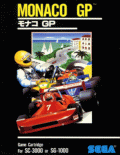
































Monaco GP

Monaco GP is an arcade racing game released by Sega in 1979. The game was released in three cabinet styles, a vertical upright cabinet, a cocktail table and sit-down 'deluxe' cabinet. A sequel, Pro Monaco GP, was released in 1980, and was later followed by Super Monaco GP and Ayrton Senna's Super Monaco GP II. Monaco GP was ported to the SG-1000 in 1983.
All of the scoring information appears on various LEDs located on the cabinet, including the player's score, the high score table, and the timer (Turbo, an arcade game released by Sega two-years later, presents scores in a similar style; the timer is presented on-screen). The main objective of the game, like many racing games made at the time, is to try to beat the clock. The attract mode consists solely of a static image of the track with cars passing by with the message 'Game Over' flashing at the top, and the message 'Deposit Coin' at the bottom.
The game does not have a CPU; it was the final game (not counting the updated version) made by Sega to use TTL-based discrete logic circuits (thus it is not currently supported by processor-based game emulators such as MAME). Images such as the cars and 'game over' message are stored in small custom ROM chips. Sound effects, such as the cars' engines, a siren, and the sound of wheels slipping on the pavement, are generated by operational amplifiers and other analog circuitry.
In 2003, Sega made a remake for the PlayStation 2, as a part of Sega Ages 2500 collection.
How to play:
Click on the joystick icon in the Monaco GP online emulator to see how to control the Monaco GP game









































Comments